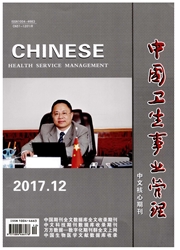

 中文摘要:
中文摘要:
目的:基层医疗卫生服务人员是提供基本医疗服务和基本公共卫生服务的主力军,是影响服务提供数量、质量和效果的核心要素。文章旨在通过分析我国各省市基层卫生机构卫生技术人员配置数量、结构和公平性,为进一步完善基层卫生人力资源相关政策奠定基础。方法:查阅中国卫生统计年鉴2006-2009年基层卫生人力资源数据,对其结构进行分析,并利用洛伦兹曲线和基尼系数对对其公平性进行评价。结果2006-2009年,全国每千非农业人口社区卫生服务机构卫生技术人员数呈迅速增长趋势,省际间Gini系数由2006年的0.65降低到2009年0.24,不公平性状况得到明显改善;每千农业人口乡镇卫生院和村卫生室卫生技术人员数较稳定,省际间Gini系数均小于0.1,公平性较好。社区卫生服务机构和乡镇卫生院人员年龄主要集中在25-44岁之间;大学及以上学历人员比例较低,中专及以下学历人员所占比例较高,尤其是在农村地区;以初级及以下职称为主;全科医师占执业医师总数的比例仅为3.5%。结论:基层卫生服务人员配置日益均衡,但是人员结构仍亟需改善。应逐步建立全科医生培养制度,完善激励机制,引导专业人才到基层执业,提升基层卫生服务能力。
 英文摘要:
英文摘要:
Objective To analyze the quantity,structure and equity of grassroots health professional allocation in China,and provide basis for improving the relevant policies.Methods The data of grassroots health human resources was obtained from China Health Statistical Yearbooks from 2006 to 2009 and analyzed.And its equity was evaluated with Lorenz Curves and Gini Coefficient.Results The number of health professionals in community health service institutions per thousand non-agricultural population kept rapid increasing.The Gini Coefficient among different provinces was reduced from 0.65 in 2006 to 0.24 in 2009.There had stable number of health professionals in township health centers per thousand agricultural populations.And the Gini Coefficient among different provinces was less than 0.1.The age of health professionals was mainly from 25 to 44 years old.Most of these health professionals had education background of no more than technical secondary school.And few of them had higher professional title.Only 3.5%of them were general practitioners.Conclusion The allocation of grassroots human resources is in balancing,but the structure still needs to be improved.The educational system of general practitioners should be established.And the incentive mechanism should be improved to intensify the ability to primary health care.
 同期刊论文项目
同期刊论文项目
 同项目期刊论文
同项目期刊论文
 期刊信息
期刊信息
